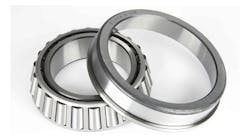Halliburton manufactures drills bigger than life, and for challenging applications.
In the 1998 movie Armageddon, viewers saw a drilling team obliterate a fictitious asteroid by using a real drill bit that was part of a life-sized, gigantic drilling machine.
To help to create that authentic machine, Halliburton, which excels in bit optimization science used for drilling hard rock and hard-to-drill formations, provided a large (28 in. dia.) drill bit for the movie.
The typical application for Halliburton’s drill bits is oil recovery, not motion pictures.
And, today, recovering oil is more critical than ever. Worldwide energy resources are being stretched tight with the demand for oil and other energy sources greater than ever and expected to climb.
Since 1919, Halliburton has done its part to serve the world’s energy needs. The company promises its customers it will “deliver the reservoir” of oil by providing innovative, quality well-site services and equipment that includes the design and manufacture of the bits that are used to drill through rock. Its customers include Exxon, Mobil and British Petroleum, and they depend on Halliburton’s drill bits for efficient down hole drilling.
Guaging Drills—A Sticky Situation
At Halliburton’s 270,000-sq.-ft., 450-employee facility in Conroe, Texas, employees produce the company’s drill bits that range in size from 2 3/8 in. to 30 in.
The bits are manufactured under stringent guidelines to provide maximum performance.
Standards include meeting tolerances of +/- 0.001 in. in some applications and +/- 0.0001 in. in others.
Tight tolerances are not the only gauging challenge Halliburton’s calibration technicians have. They often measure parts in harsh, wet and difficult conditions, and they are always conscience of keeping costs down.
“Frequently, we have to check parts with coolant dripping on the gauges,” Alex Morris, senior gauge calibration technician for Halliburton, said.
“We use a variety of gauge types and brands in our shop. We were routinely confronting situations where our calipers and micrometers were simply not performing well. The tools were not holding the tolerances we require, and the coolants were often gumming up the tools so that we could not use them to measure parts. We were constantly replacing micrometers and calipers, typically eight or nine per month,” Morris said.
Halliburton contacted the L.S. Starrett Co. to solve its dilemma. Starrett makes precision measuring hand tools.
To begin, Halliburton examined Starrett Electronic Calipers. One of the tests that Halliburton used to determine the effectiveness of the calipers was to drop the gauges in coolant. Morris said the calipers stood up to the test and performed repeated measurements accurately after being submerged.
Halliburton chose Starrett’s No. 797 Series Electronic Calipers. These tools are made in accordance with the international standard IP65 to provide protection against liquid and dust contaminants, making them suitable for harsh manufacturing environments. The calipers are designed to maintain their accuracy while resisting coolant and contaminants such as water, dust, dirt and metal chips.
“When the old calipers were replaced with the Starrett 797 Calipers, the operators could not believe how much better they performed,” Morris said, adding that his shop’s operators found the Starrett calipers easy to use even with coolant dripping on them.
The calipers are equipped with an extra large display that has a character height of 0.310 in. to make them easy to read.
Halliburton also needed micrometers for drill bits smaller than 1 in. that could maintain accuracy under similar harsh and wet conditions.
The company chose Starrett’s No. 795 Series electronic micrometers that also are designed to provide protection against coolant, water, chips, dirt, dust and other contaminants in hostile ship environments. These micrometers are built in accordance with international standard IP67 to provide protection against immersion in liquids. Additionally, the 795 micrometers are made with an extra large — .275 in. — high-contrast digital readout and have push-button features that provide zero at any position. They also are made with the capability to retain and to return to the true zero reading of the micrometer and instant conversion from English to metric measurement.
Guaging For Difficult Conditions
Halliburton looked at performance factors to find micrometers for the drills it makes that are larger than 1 in.
Calibration technicians use the micrometers during the finishmachining stage, typically while the part is on a 4-axis CNC lathe. The part cannot be removed from the machine for inspection, so measuring them can be awkward.
Holding tolerance during this process is critical, and older micrometers were not proving effective.
Halliburton determined that Starrett 733 electronic micrometers could provide it with the range of functionality it required.
Starrett’s 733 line offers fullfunction electronic outside micrometers that have the ability to output measurements to peripherals. A large, high-contrast LCD digital readout is designed to be easy to read to reduce errors, and it is made with a hard and stable one-piece spindle to ensure accuracy.
“When the old micrometers were replaced, I received a lot of the same type of feedback from the operators. They said the new micrometers held tolerances better and would repeat consistently,” Morris said.
“In all, the Starrett tools have improved our gauge repeatability and reproducibility by 50 percent,” he said, adding that the new gauges hold up on the shop floor.
Morris also said that the Starrett hand gauges for calipers and O.D. micrometers have saved Halliburton between $3,000 and $8,000 dollars over a six month period. As an example of the savings, Morris said Halliburton no longer has to replace a micrometer or caliper eight or nine times a month.





